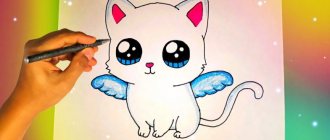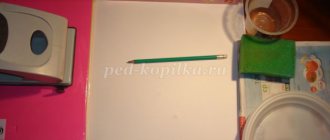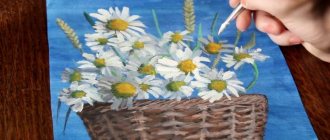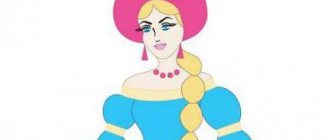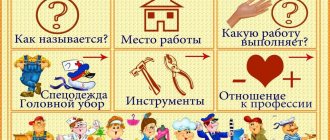Notes on drawing in a senior speech therapy group Topic: “Self-portrait”
Program content:
- Teach children to draw a self-portrait, conveying the features of their face in the drawing.
- Learn to position parts of the face correctly.
- To consolidate children's knowledge about the portrait genre, that the artist in a portrait conveys not only external resemblance, but also the inner world of a person, his character, mood.
- Develop the ability to draw on the entire sheet, using various art materials (pencils, felt-tip pens, wax crayons, watercolors).
- Cultivate an interest in drawing.
Integration of educational areas: speech development, cognitive development, artistic and aesthetic development, physical development. Material : mirrors, pencils, album sheet, illustrations, portrait reproduction, supporting drawings to show stages of work. Methodological techniques: Conversation, teacher's story, examination of illustrations with a portrait, use of literary words, individual work during the lesson, summing up. Dictionary: Portrait, self-portrait. Preliminary work: • Examination of portraits of artists and poets. • Consideration of thematic dictionary in pictures from the series “Human World” on the topic: “Parts of the body.” • Drawing portraits with a simple pencil. • Didactic game “Name it affectionately”, “Name the parts of the head”, “Name what a person has 2”, etc.
Progress of the lesson
Children stand in a circle and greet each other with a smile. Educator: Yesterday we had an exhibition of new paintings in our group. Who remembers what genre of painting they belong to? Children: To the “portrait” genre. Educator: Who will remind you what a portrait is? (Children's answers: A portrait is...) Educator: Who creates the portrait? Or maybe the artist can draw himself. Educator: This portrait will be called a self-portrait. A self-portrait is also a portrait, but only when the artist conveys his facial features, his character and mood in the drawing. Do you think it is convenient to paint a self-portrait from memory or by looking in the mirror? Children: Looking in the mirror, it will look more similar. Educator: Do you want to become an artist and learn to draw your own self-portrait? Now I will teach you. Let's look at the portrait of this boy so that you depict the eyes, nose, mouth on the face in the right places. — What is the best way to place a sheet of paper (vertically or horizontally)? — What shape is a person’s head? (I trace the head in the portrait with my finger. We make a sketch with a simple pencil, without pressing, so that the lines are thin and can be corrected with an eraser, I draw an oval on the sheet). Place your hand on your forehead. A person's eyes are located below the forehead, in the middle of the face. What shape are they? (oval with sharp corners, I draw the eyes, explaining that the distance between the eyes is small, no more than one eye. Inside the eye there is a colored circle and a small black pupil.) - What is above the eyes? (Eyebrows.) - The nose is located between the eyes, starts from the eyebrows, ends in the middle from the eyes to the end of the face. — From the tip of the nose to the end of the face, there are lips in the middle. - Children, look at each other. Do you see that the upper lip is different in shape from the lower? There are, as it were, two waves on the upper lip, and one on the lower lip (I draw the lips). - Below the lips is the chin. Place your hand on your chin. — We draw ears on the sides, they start at eye level and end at the level of the tip of the nose. To summarize: - Where are the eyes located? -Where is the nose located? - Lips? - Ears? The neck is narrower than the face, and the shoulders are wider than the head (I show it in the portrait). Look in the mirror for the color of your eyes, hair, hairstyle, and top of your clothes. Go to the tables, mirrors, your hands and diagrams will help you in your work; before you start working, let’s get our fingers in the working mood. Finger gymnastics “Friendship” In our group, girls and boys are friends. (connect your fingers in a “lock”) We will make friends with your little fingers. (touching the fingertips of both hands) One, two, three, four, five - start counting again. (paired touch of fingers from the little fingers) One, two, three, four, five - we finished counting. (hands down, shake your brushes) While drawing, you can look in the mirror to better and more accurately convey the features of your face. We try to draw in such a way that we can find out who is depicted in this picture. (during work, I give advice and help if necessary). At the end of the work, the children bring their drawings to the “Our Group” panel. Analysis. Did Styopa place his eyes, nose... correctly? Children, do you think your parents recognize you in self-portraits? Do you think Maxim (Kirill), your mother will recognize you? Why? Each of you tried to draw a self-portrait. I think all mothers will recognize you and admire your self-portraits. I draw your attention to the fact that we can make a portrait of the group, I suggest you cut out your self-portrait a little later and paste it on, and we will get a portrait of ours, which we will hang in the locker room.
Preview:
Municipal preschool educational budgetary institution
combined kindergarten No. 67, Sochi
on artistic and aesthetic development
on topic: “SELF PORTRAIT”
for older children
N.V. Beloborodova, teacher
Vocabulary: portrait, single portrait, group portrait, self-portrait.
Technologies used: health-saving, person-oriented.
Preliminary work: looking at photographs and portraits, drawing portraits of mom and dad.
1. Introduction to the situation.
Educator: Guys, in every house there are photographs of grandparents, mothers, fathers, and friends. We look at them and remember where we were, how we lived, how we dressed.
Photos can tell a lot. Previously, when there were no cameras, artists reflected various events in people's lives. More often they painted portraits of people.
Look at the portraits of your moms and dads. In addition to external resemblance, you sought to convey the character of a person, his spiritual world. By facial expressions we learn about the feelings that people experienced - joy or sadness... Each person is unique and inimitable.
We'll do some magic with our eyes. Let's draw a huge circle! We will draw a window and a huge log. Let's draw an elevator running: Eyes down, eyes up! Everyone closed their eyes: one-two! Head is spinning. We blinked our eyes, Instantly the garlands sparkled. We look straight and forward - It’s a plane rushing... Blink once, blink twice - Our eyes are rested!
Performed sitting at tables, children “draw” a circle with their eyes, without turning their heads, “draw” a window, “draw” a log
look down, look up
close your eyes tightly (3-5 sec.)
blink your eyes for 3-5 seconds.
look straight ahead
blink your eyes for 3-5 seconds.
3. Introduction of new knowledge.
Educator: A portrait is an image of a person; a self-portrait means that a person is the author of his own portrait, he draws himself.
Take a mirror and carefully examine your face, eyes, their color, eyebrows, nose, hair, hairstyle, clothes, etc. Play with your facial expression - show sadness, joy, surprise.
All this is only yours, individual.
This is exactly how artists painted their self-portraits, looking at themselves in the mirror.
Physical exercise “Artists” (exercise “Drawing in the air”):
Let's make the background of the picture (with both hands at once)
4. Introduction of new knowledge into the knowledge system.
The teacher invites the children to draw themselves while looking in the mirror.
As the work progresses, the teacher reminds the children not to forget small details: eyebrows, eyelashes, bangs, etc., because all the little things are important in the drawing. They reflect the unique character of a person.
Repeat that children draw a self-portrait - i.e. themselves.
At the end of the lesson, look at the portraits.
Reflection. What was particularly successful? What didn't work? What were you surprised by during the lesson?
OOD progress:
A quiz is being held “Distribute the paintings by genre of fine art”
.
The teacher shows reproductions of paintings by famous artists and reports that in all these paintings the artists depicted themselves ; such paintings are called self-portraits .
Then the teacher shows reproductions of paintings by famous artists in the plot of which the artist depicted himself in various images : in a theatrical costume, in the image of a rich , accomplished man, a pierrot...
Reports that artists love to depict themselves in their paintings and very often, they use various images - these can be real or non-existent images , fairy-tale or literary characters.
Then there is a game where you can laugh and move around.
Pre-prepared attributes are laid out on the table. Children choose their favorite elements to create a fairy-tale image and “show off”
in an imagined
image . While demonstrating their image , each child approaches the mirror and moves and talks as his character does.
- Look at yourself in the mirror. What kind of head do you have, what kind of eyes, nose, ears, hair. I wonder how the body is connected to the head? Look how the arms and legs are attached to the body . Place your palms on your shoulders, try to wrap your fingers around your arm at the shoulder, touch your elbow, wrist, fingers. Raise your arms, bend them at the elbows, wave your palms, wiggle your fingers. How do they bend when a person sits? Pay attention to how you are dressed.
At the end of the game, each child goes to his easel.
Now take a piece of paper! Only you and no one else should appear on it! In this drawing you will be the main one, depict yourself in the image of your favorite character . What does he like to do? Don't forget to draw where you are, when and what your mood is.
On the topic: methodological developments, presentations and notes
GCD for artistic and aesthetic development “We draw a still life” for children of the older group.
Summary of educational activities in the educational field “Artistic and Aesthetic Development” on the topic: “Winter Christmas trees” in the senior group.
Abstract of GCD artistic and aesthetic development On the topic: “Horses” for children of the older group.
Summary of continuous educational activities in the educational field “Artistic and aesthetic development” (drawing) in the senior group.
This summary is intended for teachers in preschool educational institutions. The goal is the development of fine motor skills of the hands in modeling from salt dough.
Goal: formation of positive motivation for educational activities through applications.
a comprehensive lesson with elements of experimentation for senior preschool age on the topic “Space”.
Source
Outline of the OOD for children of the senior group “Self-portrait. Drawing a self-portrait in a fairy tale"
Natalia Kalutskaya
Outline of the OOD for children of the senior group “Self-portrait. Drawing a self-portrait in a fairy tale"
Type of OOD: thematic drawing ( drawing from imagination , conversations about art.
TOPIC: “ Self-portrait . Drawing a self-portrait in a fairy tale image »
OBJECTIVE: Task “ Self-Portrait ”
aimed at identifying
“I”
image .
Educational: identifying ideas about oneself (one’s body, one’s qualities, capabilities, abilities, mood, one’s immediate environment, i.e., what attracts the child in the surrounding reality and what he values most, how he reflects his attitude to the world in visual arts
Educational : Consolidation of knowledge about the genres of fine art . To consolidate mastery of the techniques of drawing a person’s face with paints, to convey the characteristic features of the face, to maintain proportion and shape.
Developmental: Development of artistic taste, independence. In the drawing, tell about yourself : what I look like, what I am like, how I differ from others. What are the objectives of such an activity? It allows you to create an atmosphere of focus on the questions “Who am I?”
,
“what am I?”
, an atmosphere of self-absorption, allows the child to imagine himself in different
images of fairy-tale and cartoon characters .
For the teacher. Presentation with reproductions of paintings by famous artists, quiz “Distribute the paintings by genre of art”
in the program for the interactive whiteboard and
“Guess the genre of art”
, instructional diagrams: step-by-step execution of a portrait of a person, reference drawings to show the stages of work.
For children . White sheets of paper of the same size, paints, brushes, jars of water, napkins.
Methods: verbal (explanation, story , visual ( samples , illustrative material, practical ( drawing )
.
Preview:
Lesson notes for the senior group
1. Get acquainted with the portrait of the artist Dmitry Grigorievich Levitsky.
2.Learn to write a descriptive story about your face.
3. Exercise children in drawing a self-portrait using the “image in the mirror” method.
4.Cultivate a love and interest in fine arts.
5. Develop attentiveness and observation.
6. Evoke an emotional response, help to feel and understand the beauty depicted in the portrait.
Activation of the dictionary: portrait, self-portrait.
Material for the lesson: painting by D.G. Levitsky, sheets of paper, paints, mirrors.
Preliminary work: We looked at photographs of children that they brought from home, the children told who was shown in the photographs, what kind of mood people were in, when they usually were in such a mood; drawing portraits on the theme “My Beloved Mommy”, drawing portraits “Cheerful Clown”.
Progress of the lesson.
Educator: Guys, I suggest you play the game “Get to know yourself”
. Pick up a mirror and admire yourself, you are so different. I will talk about one of you, that is, I will draw a verbal portrait, and you try to recognize yourself (description of 2-3 children: eye color, hair, shape of the nose, eyebrows, face shape).
Educator: Guys, tell me if the picture depicts one or more people. What is this painting called?
Educator: Correct (showing several reproductions)
.
You and I looked at the portraits of artists, and each of you saw yourself in the mirror. What is the name of the image of a person when the entire face is visible, straight on?
Educator: Good guys, that’s right! And now I will show you several portraits where a person is depicted sideways , and only part of his face is visible.
Educator: Now let's rest a little and play. I will show the silhouette of a fairy tale hero in profile, and you try to recognize and name him (showing silhouettes of fairy tale heroes)
.
Children: Pinocchio has a long nose. Baba Yaga has a hooked nose and a scarf on her head. Dunno has a big hat.
Educator: Let's have a little rest, guys.
He spread his arms to the sides,
Apparently I didn't find the key.
To get us the key,
You need to stand on your toes.
